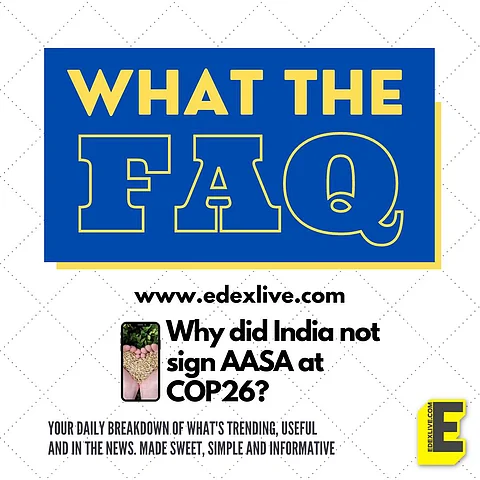

The ongoing COP26's Action Agenda for Sustainable Agriculture made some waves this week, with the President of COP26, UK's Alok Sharma saying, "The commitments being made today show that nature and land use is being recognised as essential to meeting the Paris Agreement goals, and will contribute to addressing the twin crises of climate change and biodiversity loss."
It was also initially reported that India was among the 27 countries who signed up for it. However, India's representative at the summit, Gaurav Khare, categorically stated that India had chosen not to adopt the AASA, since it already had a homegrown plan for sustainable agriculture practices, called the National Mission for Sustainable Agriculture (NMSA). We dig around to discover what exactly the NSA is, how it compares with the AASA, and what India's stand on sustainable agricultural practices has been over the years
1. What is the NMSA?
The National Action Plan on Climate Change (NAPCC) was introduced in the year 2008 by the UPA government. The NMSA is one of the eight missions functioning under the ambit of the NAPCC. Its objective was to ensure sustainable development and reduce emissions in the country. The NMSA's focus was on reducing rice production which produced methane, tending to soil health and developing sustainable irrigation in the farmlands.
2. What are the schemes under the NMSA?
Soil Health Card (SHC), Paramparagat Krishi Vikas Yojana (PKVY), Mission Organic Value Chain Development in North Eastern Region (MOVCDNER) and Sub Mission on Agroforestry (SMAF) were the original schemes launched with the plan. Over the years, Pradhan Mantri Krishi Sinchayee Yojana (PMKSY) and the Restructured National Bamboo Mission (NBM) were also introduced.
3. What is the AASA?
'Sustainable Agriculture Policy Action Agenda for the Transition to Sustainable Agriculture and Global Action Agenda for Innovation in Agriculture' was a pledge signed by 26 participating countries at the COP26, excluding India. This included a list of commitments introduced and adopted by the countries in order to reduce carbon emissions from agriculture and incorporate science to make farming sustainable. The countries also sought to amend their agriculture policies to "protect food supplies from climate change." For example, Brazil committed to reducing its emissions by 1 billion tonnes by the year 2030, by pledging to increase the area of land cultivated under its low carbon farming programme.
4. How has the implementation of the NMSA progressed?
Slow. That's the only word to describe this process. The NAPCC was launched in 2008. A committee was set up in order to "streamline" the eight missions under the plan. However, the committee submitted its report only in January 2014, stating that the missions are required to fulfil a maximum number of their objectives in the next two or three years, and a review will be held for all missions in the year 2017. Even in the year 2019, India's agriculture constituted 16% of its carbon footprint, and the contributing factors were the very same elements — methane production from livestocking raising and rice farming, and chemical fertilisers used in the soil, that the NMSA had sought to tackle.
5. Is there any change in sight?
Year after year, Delhi is choked by smog in the winters because of stubble burning in nearby farmlands. In an interview to Edexlive, Dr GV Ramanjaneyulu, Director, Centre for Sustainable Agriculture, had said that India's aping of western methods and technology is the reason behind its failing agriculture ecosystem. It remains to be seen whether, despite the tardy progress in implementation, the NMSA will evolve to meet India's ambitions of Net Zero Emissions by 2070.
